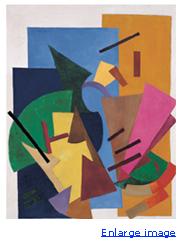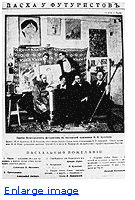








Order the catalogue
 Unlike most of
her colleagues in this exhibition, Rozanova lived and
worked in St. Petersburg rather than Moscow. The artist
never visited Western Europe, but she was certainly well
aware of the discoveries of Cubism and especially Futurism
and shared the Italians' fascination with the pictorial
rendering of speed and machines. Paintings such as Fire
in the City (Cityscape), 1914, demonstrate her
proximity to Giacomo Balla and Umberto Boccioni, while her
more synthetic compositions such as Pub (Auction),
1914, imply a strong interest in Cubist collage and the
concurrent zaum paintings of Kazimir Malevich with
their 'nonsensical' collocations of fragmentary phenomena.
As was the case for Malevich, the zaum compositions
were a crucial exercise in the extrapolation, reduction,
and removal of narrative elements and led directly to
Rozanova's non-objective paintings of 1916-18.
Unlike most of
her colleagues in this exhibition, Rozanova lived and
worked in St. Petersburg rather than Moscow. The artist
never visited Western Europe, but she was certainly well
aware of the discoveries of Cubism and especially Futurism
and shared the Italians' fascination with the pictorial
rendering of speed and machines. Paintings such as Fire
in the City (Cityscape), 1914, demonstrate her
proximity to Giacomo Balla and Umberto Boccioni, while her
more synthetic compositions such as Pub (Auction),
1914, imply a strong interest in Cubist collage and the
concurrent zaum paintings of Kazimir Malevich with
their 'nonsensical' collocations of fragmentary phenomena.
As was the case for Malevich, the zaum compositions
were a crucial exercise in the extrapolation, reduction,
and removal of narrative elements and led directly to
Rozanova's non-objective paintings of 1916-18.
 For
Rozanova color was the essence and justification of
abstract painting. In fact, she denoted her pictorial
system as 'color painting,' emphasizing that conception had
nothing in common with the world of physical objects and
that painting should be self-referential, not imitative.
Some would argue that, in their kinetic play and
monochromatic fields, Rozanova's abstract paintings, such
as Green Stripe (Color Painting), 1917, are even
more radical, more engaging, and more experimental than
Malevich's monochromes of the same period. Indeed,
contemporaries implied that the 'father of Suprematism' was
envious of his younger colleague's sharp intelligence and
original vision.
For
Rozanova color was the essence and justification of
abstract painting. In fact, she denoted her pictorial
system as 'color painting,' emphasizing that conception had
nothing in common with the world of physical objects and
that painting should be self-referential, not imitative.
Some would argue that, in their kinetic play and
monochromatic fields, Rozanova's abstract paintings, such
as Green Stripe (Color Painting), 1917, are even
more radical, more engaging, and more experimental than
Malevich's monochromes of the same period. Indeed,
contemporaries implied that the 'father of Suprematism' was
envious of his younger colleague's sharp intelligence and
original vision.Top right: Non-Objective Composition (Flight of an Airplane), 1916. Oil on canvas, 118 x 101 cm. Art Museum, Samara.